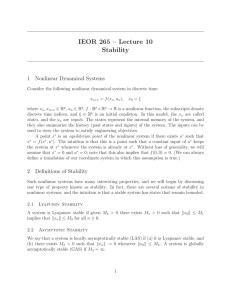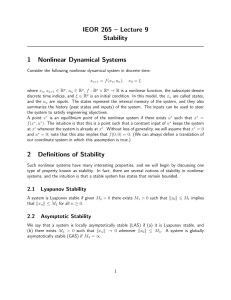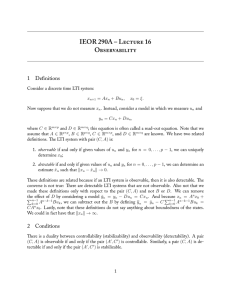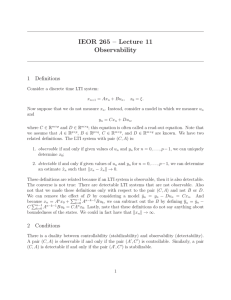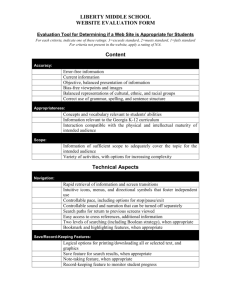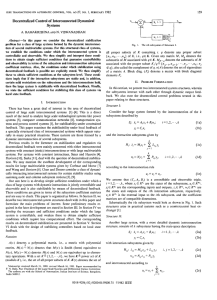IEOR 290A – L 15 C 1 Definitions
advertisement
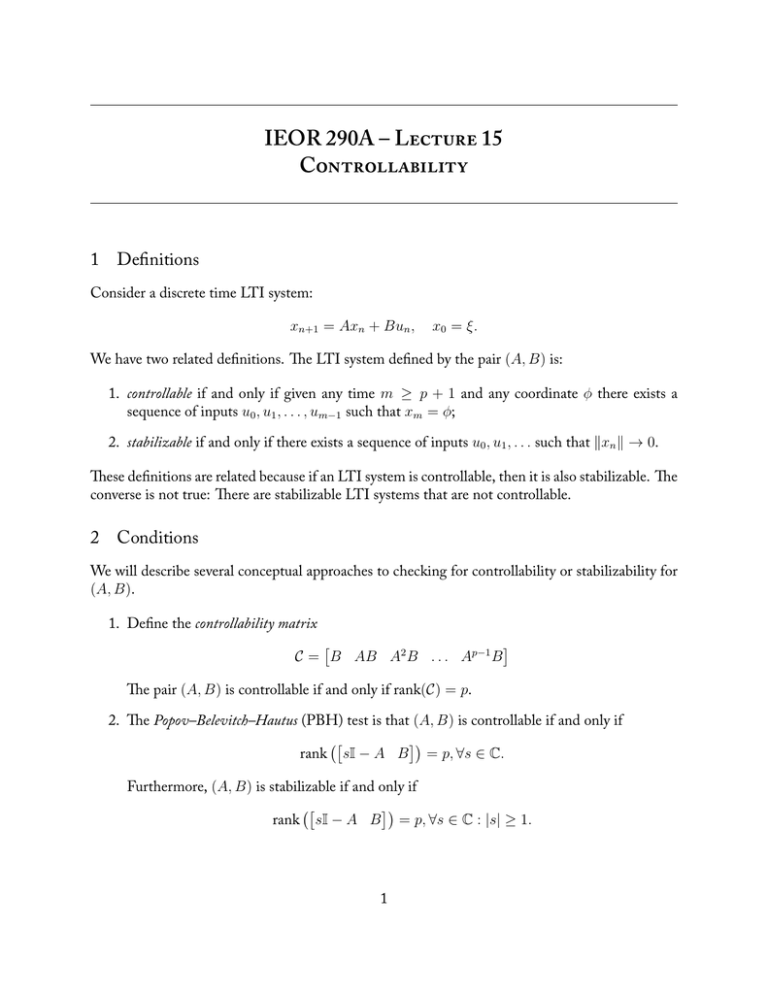
IEOR 290A – L 15
C
1
Definitions
Consider a discrete time LTI system:
xn+1 = Axn + Bun ,
x0 = ξ.
We have two related definitions. e LTI system defined by the pair (A, B) is:
1. controllable if and only if given any time m ≥ p + 1 and any coordinate ϕ there exists a
sequence of inputs u0 , u1 , . . . , um−1 such that xm = ϕ;
2. stabilizable if and only if there exists a sequence of inputs u0 , u1 , . . . such that ∥xn ∥ → 0.
ese definitions are related because if an LTI system is controllable, then it is also stabilizable. e
converse is not true: ere are stabilizable LTI systems that are not controllable.
2
Conditions
We will describe several conceptual approaches to checking for controllability or stabilizability for
(A, B).
1. Define the controllability matrix
[
]
C = B AB A2 B . . . Ap−1 B
e pair (A, B) is controllable if and only if rank(C) = p.
2. e Popov–Belevitch–Hautus (PBH) test is that (A, B) is controllable if and only if
([
])
rank sI − A B = p, ∀s ∈ C.
Furthermore, (A, B) is stabilizable if and only if
([
])
rank sI − A B = p, ∀s ∈ C : |s| ≥ 1.
1
3. Consider matrices A such that that |(σ(A))i | < 1. e pair (A, B) is controllable if and only
if the unique solution W to
AW A′ − W = −BB ′
is positive definite (i.e., W > 0). Observe that this is an LMI and can be solved using convex
optimization approaches. Note that this W (if it exists) is equal to
W =
∞
∑
Ak BB ′ (A′ )k ,
k=0
which is known as the reachability Gramian.
4. e pair (A, B) is stabilizable if and only if there is a positive definite P > 0 solution to
AP A′ − P < BB ′ .
Note that this is an LMI and can be solved using convex optimization approaches.
3
Linear Feedback
e concepts of controllability and stabilizability are important because of the following result: An
LTI system (A, B) is stabilizable if and only if there exists a constant matrix K ∈ Rp×q such that
choosing state-feedback input u = Kx leads to a stable system
xn+1 = Axn + Bun = Axn + BKxn = (A + BK)xn ,
meaning that the eigenvalues of A + BK lie within the complex unit disc.
e condition of controllability is even more powerful. Let λ1 , λ2 , . . . , λp ∈ C be fixed complex
numbers. If (A, B) is controllable, then there exists a K such that the eigenvalues of A + BK are
precisely the λ1 , λ2 , . . . , λp that were chosen.
4
Finite Horizon Linear Quadratic Regulator (LQR)
Consider the following optimization problem
{ N
}
∑
min
x′n Qxn + u′n Run : xn+1 = Axn + Bun ,
n=0
where Q > 0 and R > 0 are positive definite matrices. e minimizer is given by un = Kn xn ,
where
Kn = −(R + B ′ Pn B)−1 B ′ Pn A
and Pn is defined recursively by PN = Q and
Pn−1 = Q + A′ (Pn − Pn B(R + B ′ Pn B)−1 B ′ Pn )A.
e value function of this optimization is V (x0 ) = x′0 P0 x0 .
2
5
Infinite Horizon Linear Quadratic Regulator (LQR)
Consider the following optimization problem
{∞
}
∑
min
x′n Qxn + u′n Run : xn+1 = Axn + Bun ,
n=0
where Q > 0 and R > 0 are positive definite matrices. Note that this minimum may not be finite
unless we impose additional restrictions.
In particular, suppose that (A, B) is stabilizable. en the minimizer is given by un = Kxn
(i.e., state-feedback with constant gain), where
K = −(R + B ′ P B)−1 B ′ P A
and P > 0 is the unique solution to the discrete time algebraic Riaccati equation (DARE)
P = Q + A′ (P − P B(R + B ′ P B)−1 B ′ P )A.
e value function of this optimization is V (x0 ) = x′0 P x0 . Furthermore, A + BK is stable. ere
is an alternative characterization of this P as the solution to the following LMI:
max tr(P )
s.t. P ≥ 0
[ ′
]
A PA + Q − P
B′P A
≥ 0.
A′ P B
R + B′P B
3
